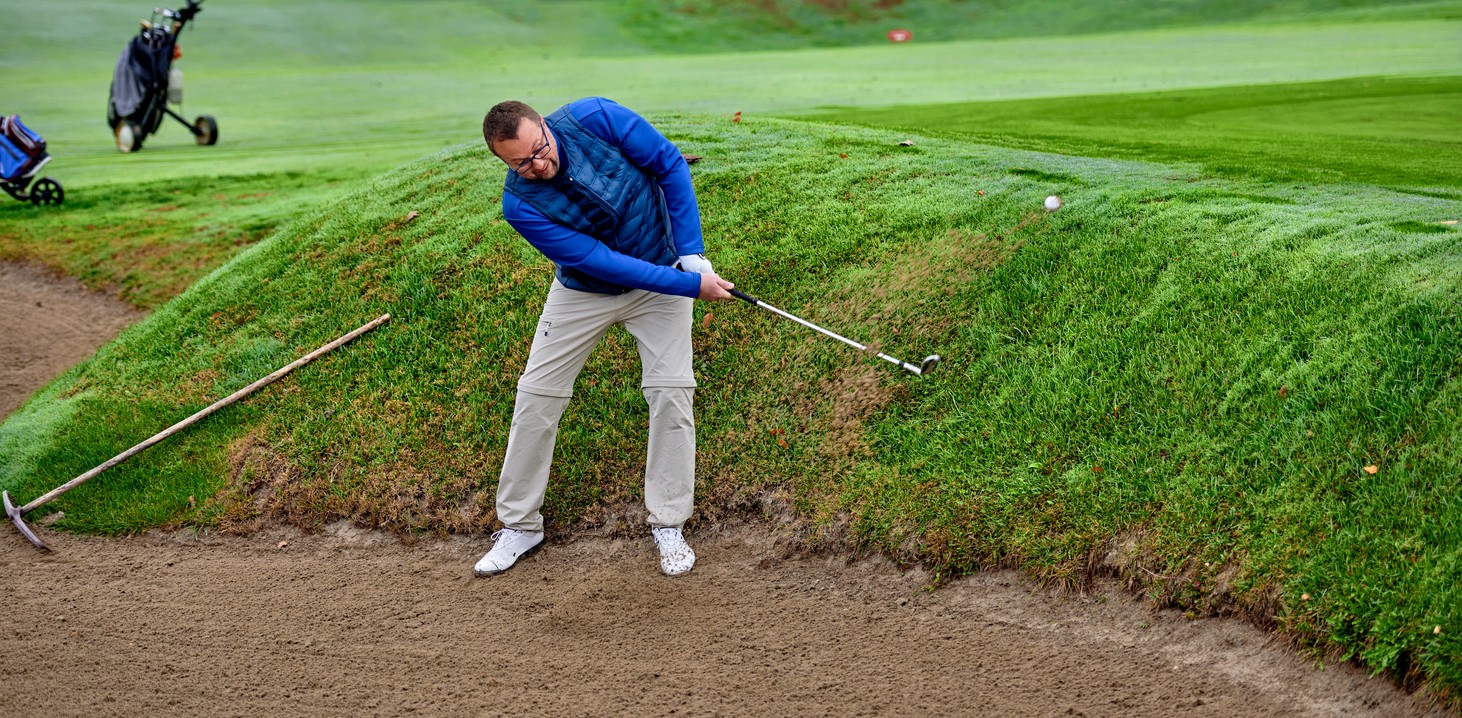A round of golf comes with plenty of booby traps and bogey traps, so it takes spirit to battle the elements and your daily abilities. You’ve got to be physically consistent but adaptable to weather and course conditions. And while experience is a great teacher, we all find ourselves in a rut from time to time.
So, if your short game is struggling, consider these golf short game tips for getting back in the swing of things.
Chip Shots

Wedge play is crucial to golf competency, so let’s start with some chipping tips. We’ll consider your short game to be anything around the green and within 100 yards of the pin. At that distance, it’s not strength or power that’s important; you need precision and finesse – or you’ll never get up and down in regulation.
You’ll likely use a pitching wedge to give your ball a high loft to get a soft landing on the green when you’re at the outskirts of that 100-yard distance. You may still need that high loft for a shot off the fringe or out of a bunker, but in most cases, a chip shot isn’t a full swing like a pitch takes.
Instead, a chip shot is a less extended swing. If you imagine the backswing and follow-through as the hands of a clock, you’re only backing up to about 8 o’clock and following through to about 4 o’clock. You’ll be using a high-loft club, but you’re looking to pop the ball up onto the green, where it will roll towards the pin. And you’re coming down more directly at the ball. Don’t worry; the slower swing will allow you to keep the clubhead under the ball.
If you find an obstruction between you and the pin, open the clubface before gripping the club and plant your feet slightly to the left of the hole. This will allow you to get that loft you need to clear a bunker but still stop close to the pin without much ball run. Your ideal club for this open-face or flop shot is a 58 or 60-degree wedge.
1. Relax Your Grip
Golf advertising concentrates so much on power and distance that many players think they’ve got to muscle every shot. You don’t! In fact, while club speed and strength are essential for distance, a tight grip reduces full extension, which leads to hooking the ball. Using a lighter pressure with your fingers around the shaft – not curled into the palm of your hand – results in a better ball strike and more distance.
Around the green, that relaxed grip allows you to release the club freely, and your accuracy will improve significantly. Less effort, better results!
If you’re unsure about the grip, just put your lead hand’s thumb into your palm and squeeze it while bending slightly into your golf stance. Now release the grip, place your thumb along your fingers, and use them to hold your thumb. Notice the difference in the position of your wrist and the reduced strain on your forearm? Yup, it’s substantial.
2. Let Your Whole Body Move
Physical mobility is critical to golf. A little stretching and a few practice swings before your round significantly impact your scores. Swinging a club with a stiff motion is hard on your game and body. Instead, concentrate on being more fluid.
Short shots demand accuracy over distance and using sweeping and fluid motions helps you keep the clubhead aimed towards the ball for a perfect club strike. If you practice a slow-motion chip shot, you’ll notice that while your hip movements aren’t as exaggerated as a full swing, you’ll still be bending your lead knee toward the ball during your backswing and your back knee inward during your follow-through. It’s like a dance move as the weight shifts back, and your feet and ankles lean one way then the other.
That weight shift and fluid motion in every shot maintain proper balance. And the balance will keep you from leaning back on your swing while allowing your body to lean into your swing.
In truth, it’s not so much that your lead shoulder is leaning towards the target. It’s more the angle of your iron. That means you want to move toward your target on your downswing to increase your shaft lean.
To get the best effects, set your hands slightly in front of the ball at address to get that forward shaft lean later in your follow-through as you hit down on your chip shots. If you’re pitching and need the high loft, you’ll do the opposite and set up with a bit of reverse shaft lean to lend height.
Not sure what you are doing? A long divot after striking the ball indicates the downward motion and forward lean you want on your chip shots. Just groom your damage before you enter the green.
3. The Importance of Your Leading Arm
If you’re a righty, your left arm dominates control of your swing while the right arm controls the swing for left-handed players. That’s important because it puts your usually dominant hand and arm in a subservient position. And since you use your dominant hand more, it’s stronger – as are the chest and shoulder muscles in most cases. What to do? Learn cooperation and symmetry.
Your body – especially your arms – needs to work in harmony, without the lead arm pulling on your downswing or your more muscular arm pushing through. To help achieve this, take a practice chip shot while looking at your lead wrist. As you transition from backswing to downswing, you’ll notice the back of your lead forearm and wrist point away from your chest. If you pull that arm through your swing, it will stay pointed only slightly away from your body.
However, if you rotate your lead arm as you should, your wrist will mimic the clubhead – squaring to the ball and in line with your target. And, your hands will be leading (leaning) into impact, which gives you that nice shaft lean for a better shot.
4. Understand the Bounce
As mentioned before, leaving a divot after striking the ball is fine. Digging up a chunk of turf (a chunk) by getting the lead edge the clubhead caught behind the ball is not. The bounce is the angle formed by that leading edge, the rest of the club head, and the ground. Getting that bounce of the club to slide under the ball as you make contact is the key. Don’t worry; you don’t have to break out a protractor and figure out the angle.
Advantages of the Bounce:
- No early hit of the ground creating a chunk
- No blading the ball by hitting directly with the leading edge of your wedge
- No jamming your wrist with hard contact with the turf
- Smooth and solid strikes with the clubface
- Additional speed as the clubface continues under the ball
- Proper ball spin for the best roll
Without the bounce, it’s easy to duff a shot a foot or two or blast what should have been a short chip across the green. Your aim and distance will be more accurate with a nice bounce that provides better contact with your ball. Take advantage of it!
Putting

Sometimes, getting to the green seems like a victory in and of itself. But golf’s even more fun when you find that confidence to attack the cup instead of just lagging up close. A few simple putting tips can bring that about.
1. Focus on the Ball
After checking your path to the cup and addressing your ball:
- Give your full breathing attention.
- Recheck the pin, but as you putt, keep your eyes on the ball strike and keep your head down.
- Don’t jerk your head up to watch the path of the ball.
- Wait until you’ve finished a deliberate and smooth follow-through and the ball is away from your club.
- Watch as it drains the hole.
2. Lean Forward
Putters have a small 3–4-degree loft to get the ball up slightly at impact. You’ll notice this if you tend to strike the ball hard with little follow-through. A slight forward lean or press can keep your putts from hopping as the putter shaft flattens the lead wrist.
This minor adjustment can be beneficial when your lead hand starts to get behind the ball at impact, which can change the impact angle of your putter.
3. Length of Backstroke
Course conditions change regularly, often during play. That’s why it’s crucial to drop a few balls on the putting green before your round. On the course, a simple rule of thumb is to measure your backstroke by about an inch for every foot needed to sink your putt. Just adjust that mental measure as you play, and you’ll be closer every putt.
Schedule a Tee Time at River’s Edge Today
If you want to test a few of these short game tips and play the best golf course in Central Oregon, schedule a tee time at River’s Edge today by booking online or calling 541-389-2828. Then, arrive early and take advantage of the extensive practice facility with a large putting surface and plenty of square footage for perfecting your chipping.
